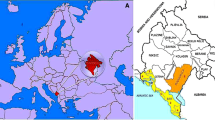Abstract
Ehrlichia canis is the agent of canine Ehrlichiosis, commonly known as canine tropical pancytopenia. This canine disease is frequent in our area, as is Mediterranean Spotted Fever in humans. Recently a few cases of human Ehrlichiosis have been described in the USA. The supposed vector of both diseases is Rhipicephalus sanguineus. In order to evaluate the cotransmission of these two diseases, we selected 498 human sera positive for R. conorii and tested them for Ehrlichia canis. None of them were positive, suggesting the lack of co-transmission of the diseases.
Similar content being viewed by others

References
CabassuJp, HarautunianG., GervaisP., BesseJ., RanqueM., Rousset-RouviereB. (1980): Un cas d'ehrlichiose canine. Le point vétérinaire 10: 61–63.
DavoustB., MackowiakM., MoreauY. (1986): Ehrlichiose canine, enquète épidémiologique. - Rev. Med. Vet. 162: 471–475.
DonatienA.A., LestoquardF. (1936): Existence d'une Rickettsia du chien. - Bull. Soc. Path. Exot. 6: 418.
Donatien, Lestoquart (1936): Recherches sur Rickettsia canis comparaison avec Rickettsia conorii. -Bull. Soc. Path. Exot. 29: 1052–1056.
EllisonR.T. (1987): Colorado tick fever or ehrlichiosis. - JAMA 258: 1731.
EwingS.A., JohnsonE.M., KocanK.M. (1987): Human infection with Ehrlichia canis. - N. Eng. J. Med. 317: 899–900.
FishbeinD.B. (1988): Human Ehrlichiosis. United States. - Epidemiologic Notes Reports. M.M.W.R. 37: 270–276.
FishbeinD.B., SawyerL.A., HollandC.J., HayesE.B., OkoroanyanwuW., WilliamsD., SikesR.K., RisticM., McDadeJ.E. (1987): Unexplain febrile illnesses after exoposure to ticks, infection with an Ehrlichia? -JAMA 257: 3100–3104.
GrovesM.G., DennisG.L., AmyxH.L., HuxollD., (1975): Transmission of Erlichia canis to dog by ticks (Rhipicephalus sanguineus) - Am. J. Vet. Res. 36: 937–940.
KeefeT.S., HollandC.J., SalyerP.E., RisticM. (1982): Distribution of Ehrlichia canis among military working dogs in the world and civilian dogs in the United States. - J. Am. Med. Assoc. 81: 236.
MaedaK., MarkowitzN., HanleyR.C., RisticM., CoxD., McDadeJ.E. (1987): Human infection with Ehrlichia canis a leucocytic rickettsia. - N. Eng. J. Med. 316: 853–856.
NyindoM.B.A., RisticM., HuxollD.L., SmithA.R. (1971): Tropical canine pancytopenia, in vitro cultivation of the causative agent Ehrlichia canis. -Am. J. Vet. Res. 32: 1651–1658.
PearceC.J., ConradM.E., NolanP.E., FishbeinD.B., DawsonJ.E. (1988): Erlichiosis a cause of bone marrow hypoplasia in humans. - Am. J. Hem. 28: 53–55.
RaoultD., WeillerP.J., ChagnonA., ChaudetH., GallaisH., CasanovaP. (1986): Mediterranean Spotted Fever, clinical laboratory and epidemiological features of 189 cases. - Am. J. Trop. Med. Hyg. 35: 845–850.
RaoultD., TogaB., ChaudetH., Chiche-PorticheC. (1987): Rickettsial antibody in southern France: antibodies to Rickettsia conorii and Coxiella burnetii among urban, suburban and semi-rural blood donors. - Trans. Roy. Soc. Trop. Med. Hyg. 81: 80–81.
RisticM., HuxollD.L., TachibanaN., RapmundG. (1981): Evidence of a serologic relationship between Ehrlichia canis and Rickettsia sennetsu. -Am. J. Trop. Med. Hyg. 30: 1324–1328.
SmithR.D., SellsD.M., StephensonE.H., RisticM., HuxollD.C. (1976): Development of Ehrlichia canis, causative agent of canine ehrlichiosis, in the tick Rhipicephalus sanguineus and its differenciation from a symbiotic rickettsia. - Am. J. Vet. Res. 37: 119–126.
StephensonE.H., RisticM. (1978): Retrospective study of an Ehrlichia canis epizootic around Phoenix Arizona. - J. Am. Vet. Med. Assoc. 172: 63.
TarasevitchI.V. (1988): Serological prospecting for ehrlichia infection of dog in the USSR. - Zhur. Mik. Epi. Imm. 1: 107.
WilliamsC., BuhlesJ.R., HuxollD.L., RisticM. (1974): Tropical canine pancytopenia, clinical, hematologic and serologic response of dogs to Ehrlichia canis infection, tetracycline therapy and challenge inoculation. - J. Infect. Dis. 130: 357–367.
Author information
Authors and Affiliations
Additional information
Corresponding author.
Rights and permissions
About this article
Cite this article
Brouqui, P., Raoult, D. & Vidor, E. Lack of co-transmission of Rickettsia conorii and Ehrlichia canis in human beings in the south of France. Eur J Epidemiol 5, 110–112 (1989). https://doi.org/10.1007/BF00145056
Issue Date:
DOI: https://doi.org/10.1007/BF00145056


